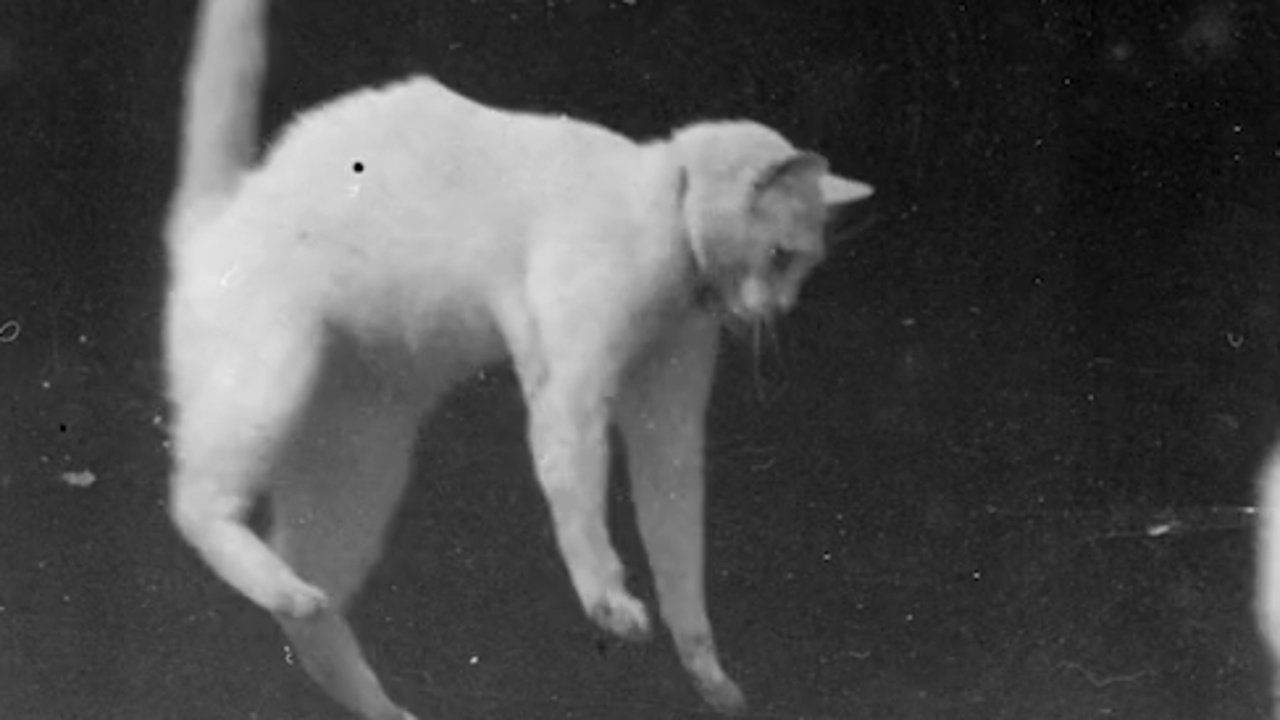See the first post in new section here.
The story of the first cinematic cats
The story of the first cats in cinema begins long before the Lumière brothers invented cinema. One of the pioneers of cinematic experiments was the British-American photographer and inventor Eadweard Muybridge. His work in the second half of the nineteenth century was an important step in the study of animal movements, including cats.
Muybridge was recognised for his series of photographs that captured movement in a sequence of frames. He used an elaborate system of cameras that triggered one after the other to create the impression of movement. One of his famous experiments involved filming a horse on the move, which allowed us to see the animal's movements in detail for the first time. However, Muybridge did not limit himself to horses; he also photographed other animals, including cats.
In a series of photographs known as "Falling Cat", Muybridge explored how cats flip over in mid-air. This experiment became important for understanding the natural movements of cats and attracted a lot of attention from the scientific and artistic world. The images of the falling cat demonstrated the incredible ability of these animals to control their bodies during free fall, which became a scientific sensation at the time.

Muybridge's work with photography became the basis for further cinematic experiments. His innovative methods of motion capture influenced the development of cinema and became an important step towards the creation of the first cinematic films featuring cats. Thus, it can be argued that the beginning of the history of cats in cinema dates back to Eadweard Muybridge's experiments.
"Falling Cat" short film.

The short film "Falling Cat" was created in 1894 by the French scientist and director Étienne-Jules Marey. The film was the first known film to feature a cat and was intended to explore the physical phenomenon known as the "cat's uprighting reflex". Marey sought to document how cats always land on their paws, and his work was an important step in the development of cinema.

Étienne-Jules Marey was a pioneer in the field of chronophotography, a technique of capturing a series of images of an object in motion to study its kinematics. To create "Falling Cat" he used his specially designed camera capable of shooting at high speed. This allowed him to capture every phase of the cat's movement from the moment it falls to the landing. Thanks to this footage, Mare was able to analyse how the cat uses its body to stabilise and rotate in the air to land on its paws.
This short film has not only scientific but also historical significance. It demonstrates the potential of cinema as a tool for scientific research and popularization of science. "Falling Cat" is also an example of how technological innovations can contribute to new discoveries in various fields of knowledge. Thanks to Marey's work, cinema began to develop not only as an entertainment medium, but also as a scientific tool for studying movement and dynamics.
Thus, "Falling Cat" was an important step in the development of not only cinema, but also our understanding of animal physiology. With his film, Etienne-Jules Marais demonstrated how science and art can interact to create innovative ways to explore and understand the world.
In 1894, William Dixon made the short film "Boxing Cats" for the Edison kinetoscope, which became one of the first examples of the use of animals in cinema. In this film, two cats are shown in a boxing match under the supervision of a human, which creates a comic effect. This film was created as part of early cinematic experiments aimed at exploring the possibilities of the moving image.
The context of "Boxing Cats" reflects the interest in new technologies and entertainment at the end of the 19th century. Cinema was in its infancy, and short films like this one demonstrated the potential of the new art form. Audiences of that era were very enthusiastic about such films, as they offered novelty and entertainment that had not been available before. "Boxing Cats" became one of the audience's favourite films due to its unusual subject matter and comic approach.
The significance of this film for early cinematic experiments can hardly be overestimated. Not only did it demonstrate the technical capabilities of the kinetoscope, but it also showed how comic elements could be used to engage the audience. "Boxing Cats" also gave impetus to further experiments with the use of animals in cinema, opening up new possibilities for directors and producers. Thanks to films like this one, cinema became an important part of the entertainment industry and cultural life of the late 19th and early 20th centuries.
The influence of the first cat films on cinema
The first films featuring cats, such as "Falling Cat" and "Boxing Cats", had a significant impact on the development of cinema. They not only demonstrated the technical capabilities of the new art form, but also laid the groundwork for future experiments in cinema. Experiments with cats allowed filmmakers to understand how to use movement and dynamics to create exciting stories.
These early films helped to expand the idea of what was possible in cinema. By observing the movements and behavior of cats, filmmakers began to experiment with new filming and editing techniques, which allowed them to create more realistic and emotionally charged scenes. In addition, cats in cinema have become pioneers, paving the way for other pets that later became popular on the big screen.
Thanks to films like Falling Cat and Boxing Cats, pets have become an integral part of cinema. They attracted the attention of viewers and made movies more accessible and interesting to a wider audience. This, in turn, helped popularize pets in movies.
In the modern world, cats remain popular characters in movies and online videos. Thanks to social media and video-sharing platforms such as YouTube, cats have become real internet stars. Videos with cats garner millions of views and are admired by viewers around the world. The interest in cats in movies is not disappearing, but rather growing every year.


[…] імена «своїх» винахідників кіно. До прикладу, перші котики в кіно з’явилися за рік до «винаходу» кіно […]